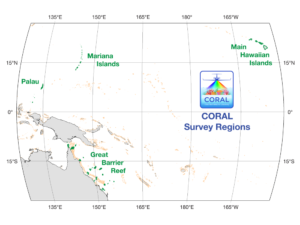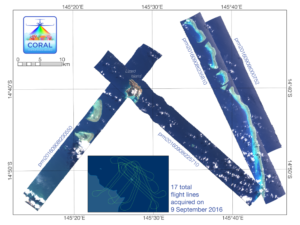NASA has launched a two-month airborne mission over the Great Barrier Reef that will provide the highest resolution images yet of the world’s largest reef ecosystem.
It might also be the beginnings of a reef monitoring system from space.
Called CORAL - the COral Reef Airborne Laboratory mission - the study combines aerial surveys using imaging spectrometer technology developed by NASA's Jet Propulsion Laboratory (JPL), with “in-water validation” provided by CSIRO and the University of Queensland.
The GBR mission is part of a three-year program also covering reef systems in the main Hawaiian Islands, the Mariana Islands and Palau.
Dr Tim Malthus, research leader of CSIRO's Coastal Monitoring, Modelling and Informatics Group said having a broader understanding of the reef’s condition and what's threatening it would help researchers better understand how it can be protected.
"Along with surveying several large sections of the reef, CORAL will also survey the health of corals in the Torres Strait, a complex high-tide area that has been historically less studied," he said.
An urgent need for better data
CORAL principal investigator Dr Eric Hochberg of the Bermuda Institute of Ocean Sciences (BIOS) said virtually all reef assessments to date relied on in-water survey techniques that were laborious, expensive and limited in spatial scope.
"Very little of Earth's reef area has been directly surveyed,” he said.
“More importantly, there are no existing models that quantitatively relate reef conditions to the full range of biological and environmental factors that affect them -- models that can help scientists better understand how coral reefs will respond to expected environmental changes.
"CORAL offers the clearest, most extensive picture to date of the condition of a large portion of the world's coral reefs.

"This new understanding of reef condition and function will allow scientists to better predict the future of this global ecosystem and provide policymakers with better information for decisions regarding resource management."
In Australia, CORAL will survey six discrete sections across the length of the Great Barrier Reef, from the Capricorn-Bunker Group in the south to Torres Strait in the north.
Two locations on the reef -- one north (Lizard Island Research Station) and one south (Heron Island Research Station) -- will serve as bases for in-water validation activities.
PRISM: Shining new light on coral reef condition
The key to this new data collection is JPL's Portable Remote Imaging Spectrometer (PRISM). PRISM peers through the ocean's surface to generate high-resolution images of reflected light in the specific regions of the electromagnetic spectrum important to coral reef scientists.

Mounted in the belly of a modified Tempus Solutions Gulfstream IV aircraft, PRISM will survey reefs from an altitude of 8500 metres to generate calibrated scientific data products.
"It provides the coral reef science community with high-quality oceanographic imagery at the accuracy, range, resolution, signal-to-noise ratio, sensitivity and uniformity needed to answer key questions about coral reef condition,” NASA CORAL project scientist at JPL, Dr Michelle Gierach said.
“PRISM data will be analysed against data for 10 key biological and environmental factors affecting coral reef ecosystems, acquired from pre-existing data sources."
CORAL will generate scientific data products describing coral reef condition, measuring three key components of reef health where data is currently limited - composition, primary productivity and calcification.
Primary productivity is a measure of how much energy is available to drive biological activity in a reef system. Calcification measures the net gain in carbonates, which determine a reef's long-term growth.
And the next step is…..
Ms Janet Anstee, who leads CSIRO’s aquatic remote sensing group, has already undertaken work in the Torres Strait with colleagues Dr Hannalie Botha and Dr Nagur Cherukuru.
“We’ve seen significant bleaching events from east to west and into the Indian Ocean and we really need to understand them,” Ms Anstee said.
“A lot of other campaigns have been of such a small scale we don’t have a holistic and wider view of the system to be able to look at the impacts of various conditions. This gives us such an opportunity to understand these processes.”
NASA data will be available publicly to all researchers to then apply their own ideas and modelling.
“We have our own modelling approach to establish different water quality parameters as well as sub-strata types,” Ms Anstee said.
“We will undertake our own processing using the CORAL data, providing maps of coral cover as well as looking at water quality.
“It’s an exciting time for us to be involved, we’re very pleased to be collaborating with the mission. What we’re doing is a precursor to an orbital mission which means we could get this kind of data on a regular basis and compare over time.”
Read more about the CORAL program.
